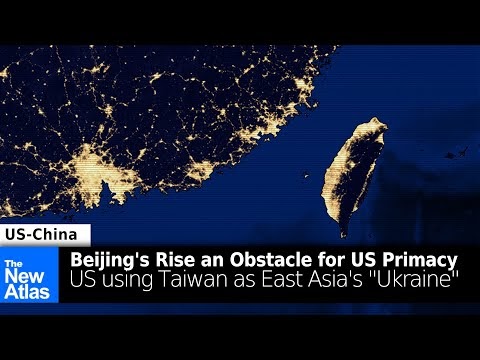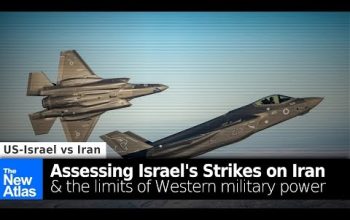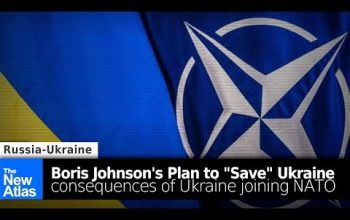February 28, 2024 (Brian Berletic – NEO) – A recent op-ed appearing in Foreign Affairs titled, “The Taiwan Catastrophe,” helps paint a clear picture of US motivations behind its growing confrontation with China and the increasingly unrealistic nature of Washington’s desired outcome.
The premise of the op-ed is built on a now declassified top-secret memo by US General Douglas MacArthur in 1950 describing Taiwan as an “unsinkable aircraft carrier,” essential not to protect the continental United States, but to preserve US primacy over Asia-Pacific thousands of miles from US shores.
By retaining Taiwan and the US military presence it was a part of which included (and still includes) Japan and the Philippines, General MacArthur noted US forces could “interdict” the ability of regional powers (then the Soviet Union, now clearly China) to “exploit the natural resources of East and Southeast Asia.”
The ability to contain China, this enables, remains Washington’s primary motivation to this day for maintaining a US military presence across East and Southeast Asia.
Containing China, Not Defending America
The US National Defense Strategy (NDS) designates “out-competing China” as Washington’s top priority. The US NDS complains that China “harbors the intention and, increasingly, the capacity to reshape the international order in favor of one that tilts the global playing field to its benefit.”
The US NDS never mentions the “international order” China seeks to displace is one that had previously occupied Chinese territory before the World Wars, stationed thousands of troops on the shores of its island province of Taiwan until 1979, and continues to place US troops on Taiwan despite recognizing the island province as Chinese territory from 1979 onward under Washington’s “One China” policy.
The same US NDS claims the US seeks to “promote a free and open Indo-Pacific,” and more specifically, “open access to the South China Sea.” The report even points out that “nearly two-thirds of global maritime trade and a quarter of all global trade” pass through the South China Sea, while implying China threatens this trade.
However, the US government and US corporations, including from across America’s arms industry, fund foreign policy think tanks like the Center for Strategic and International Studies (CSIS) which publish analysis like a 2017 report titled, “How Much Trade Transits the South China Sea?” It admits the vast majority of trade passing through the South China Sea comes from and is going to China.
The report even admits:
China’s reliance on the South China Sea leaves it vulnerable to maritime trade disruptions. In 2003, then-President Hu Jintao drew attention to the potential threat posed by “certain major powers” aiming to control the Strait of Malacca, and highlighted the need for China to adopt new strategies to address this concern.
Clearly, China has no intention of disrupting its own trade in the South China Sea. In reality, just as US General MacArthur pointed out in 1950, the US military presence in the region today is there not to protect maritime trade, but specifically to “interdict” it.
“Defending Democracy” = Maintaining US Client Regimes
Just as the US creates the illusion of protecting maritime trade as a smokescreen for in fact preparing specifically to interdict it, the US also uses other smokescreens to justify its continuous interference within and along China’s borders. This includes the island province of Taiwan itself.
The Foreign Affairs op-ed claims that the US is “defending democracy.” Yet, the political administration on Taiwan and the policies it implements are not the product of democratic self-determination, but instead are determined on the other side of the planet in Washington.
Policies like provoking Beijing, hindering trade between Taiwan and the rest of China, and channeling public funds into US weapons instead of economic development and infrastructure all demonstrably serve US interests explicitly at the expense of the local population’s own best interests.
The US seeks to maintain its presence in the Asia-Pacific not to defend a process of self-determination in Taiwan, Japan, South Korea, or the Philippines, but instead to maintain America’s political capture and control over each.
Controlling the Future of Semiconductors
The authors of the Foreign Affairs op-ed, perhaps suspecting their “defending democracy” narrative would be unconvincing, also claimed that the US must prevent China from controlling the semiconductor industry in Taiwan. The premise, upon stripping away the aurthor’s political rhetoric, lays out the bare bones of imperialism; a resource is important to the US, and thus the US must control it, even if it is thousands of miles beyond its shores.
The argument and planning by the US regarding the control of semiconductor production is fundamentally flawed. While Taiwan and the collective West hold many advantages over China in terms of semiconductor research, development, and manufacturing today, these advantages are based on historical factors that are no longer relevant. Today, the largest industrial base on Earth is located in China, not the United States. China, not the United States, produces by far more graduates in the fields of science, technology, engineering, and mathematics, all relevant to advancing all stages of semiconductor production.
Controlling Taiwan and imposing strict sanctions and export controls, not only will fail to prevent China from assuming leadership in semiconductor production, it will spur China to make the investments necessary to do it sooner and more decisively.
Ensuring American “Access” to and Control Over the Asia-Pacific
While the Foreign Affairs op-ed briefly attempts to convince readers that Taiwan’s full reunification with the rest of China would trigger a chain reaction of Chinese conquests across the region, it abruptly shifts to fears of Beijing having the power to “complicate U.S. access to East Asia, Southeast Asia, and the Indian Ocean – the littoral of the most populous, economically active part of the world.”
Just as with Taiwan’s semiconductor industry, because the “Indo-Pacific” is the most populous and economically active part of the world, the US must, for some reason, have “access” to it – part of a wider sense of American entitlement to do what Washington wants, anywhere it wants regardless of how far from US shores it may be or how it impacts the peace, stability, sovereignty, and independence of all others involved.
Another fear expressed in the op-ed stemmed from the prospect of Asia reducing its reliance on the US dollar as a reserve currency. The op-ed never explains why Asia’s best interests are served by maintaining a reserve currency controlled by interests on the other side of the planet.
The True Fear: China as an Obstacle to US Primacy
The op-ed then surprisingly cites the United States itself as an example of why readers should fear the rise of China.
The authors say:
America’s own history shows how achieving regional preeminence facilitates global power projection. Only by dominating the Western Hemisphere in the nineteenth century was the United States able to become a global superpower in the twentieth.
Then with little self-awareness the op-ed claims:
It is impossible to predict precisely how China might act as a global power, but decades of data suggest it would take a far less benign approach than the United States.
The authors claim this “data” includes China’s presence in the South China Sea and a general “massive military buildup.” The authors never explain how these two examples represent an approach “less benign” than American foreign policy.
In the 21st century alone, the US invaded and occupied Afghanistan in 2001 and Iraq in 2003. The latter resulted in over a million deaths, predicated on deliberate fabrications regarding Iraqi “weapons of mass destruction.”
In 2011, the US intervened militarily in Libya to overthrow the government in Tripoli. In 2014, the US invaded Syria, occupying the nation’s source of energy and food. In the words of then-US Deputy Assistant Secretary of Defense for the Middle East Dana Stroul, this was done as “leverage for affecting the overall political process for the broader Syrian conflict,” and as a means of withholding the reconstruction of Syria, admitting the US-sponsored conflict transformed much of the country into “rubble.”
The ongoing conflict in Ukraine today is a result of US regime change in 2014, removing an elected government determined to maintain neutrality, and replacing it with a client regime eager to serve as US proxies in war with Russia. The US is also enabling Israel’s ongoing war in Gaza, Palestine and is launching missile and air strikes at targets across Yemen.
The Foreign Affairs op-ed provides a case study in cognitive dissonance. Its authors warn of a future surrendered to an abusive superpower using its military to menace nations worldwide, acknowledging but never condemning the existing superpower (the United States) already demonstrably doing as much.
Washington’s true fear is not that China is building an international order threatening to subjugate nations worldwide, but is building an international order undermining America’s ability to continue coercing and controlling the globe.
The op-ed warns:
China alone commands an economy meaningfully larger than that of all its Asian neighbors combined, India included. China’s navy, meanwhile, boasts firepower second only to that of the U.S. Navy. And it is relatively concentrated: imagine if the entire U.S. naval fleet primarily operated in an arc from New York to New Orleans.
Yet, China was able to achieve all of this since the turn of the century without employing any of the methods of extraterritorial military aggression the US used to achieve its own regional and then global preeminence.
By pointing out that China’s military power is “relatively concentrated,” the authors are admitting, unlike America’s global-spanning military presence, China’s military is postured solely to defend Chinese territory. Such a military posture could only be perceived as a danger to those seeking to threaten Chinese territory (including Taiwan).
China’s rise across the region is not marked by invasions and networks of military bases, but by high-speed rail lines, ports, power plants, factories, and roadways. Its influence around the globe is not maintained by aircraft carrier strike groups engaged in modern gunboat diplomacy, but by fleets of container ships engaged in international trade.
Whereas Washington maintains global preeminence by bombing, China challenges it through building.
For example, in Southeast Asia where China’s high-speed rail network extends beyond its own borders, Chinese engineers literally had to disarm unexploded US ordnance dropped on Laos during the Vietnam War, before laying tracks finally connecting the impoverished land-locked country to the rest of the region.
Quite clearly, China’s approach is not similar to that of the US, but fundamentally better – so much so that the US is wholly incapable of competing against it.
Toward that end, op-eds like those found in Foreign Affairs, reflecting sentiments widely held across Washington, London, and Brussels, strain to make a case for why the world should continue under a US-led international order built on conquest and coercion, instead of an alternative international order favored by China built on cooperation and mutual benefit. Because it is an irrational argument to make, the use of fear is central in making Washington’s case.
The irony is, in order to create sufficient fear of what China may do in the future, the authors must tap into what the US has already done – or in other words – they must accuse China of becoming in fiction, what the US has already become in reality.
Brian Berletic is a Bangkok-based geopolitical researcher and writer, especially for the online magazine “New Eastern Outlook”.



